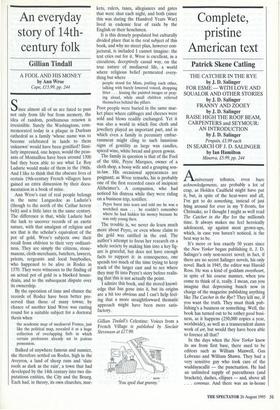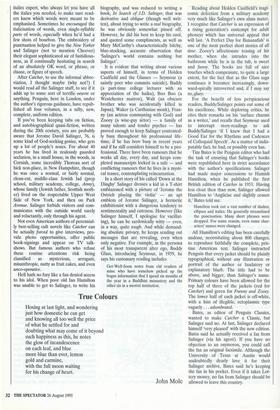Complete, pristine American text
Patrick Skene Catling
THE CATCHER IN THE RYE by J. D. Salinger FOR ESME — WITH LOVE AND SQUALOR AND OTHER STORIES by J. D. Salinger FRANNY AND ZOOEY by J. D. Salinger RAISE HIGH THE ROOF BEAM, CARPENTERS and SEYMOUR: AN INTRODUCTION by J. D. Salinger Penguin, L5.99 each IN SEARCH OF J. D. SALINGER by Ian Hamilton Minerva, L5.99, pp. 244 Anniversary tributes, even bare acknowledgements, are probably a lot of crap, as Holden Caulfield might have put it, but, in spite of the heat-wave and all, I've got to do something, instead of just lying around for ever in my Y-fronts, for Chrissake, so I thought I might as well read The Catcher in the Rye for the millionth time. It always makes me feel heroically adolescent, up against most grown-ups, which, in case you haven't noticed, is the best way to be.
It's more or less exactly 50 years since the New Yorker began publishing it, J. D. Salinger's only non-secret novel; in fact, if there are no secret Salinger novels, his only novel. Back in 1945, the editor was Harold Ross. He was a kind of goddam sweetheart, in spite of his coarse manner, when you come to think of it, really. I mean, can you imagine that depressing bunch now in charge of the magazine publishing anything like The Catcher in the Rye? They kill me, if you want the truth. They must think pub- lishing's a business or something. Well, the book has turned out to be rather good busi- ness, as it happens (250,000 copies a year, worldwide), as well as a transcendent damn work of art, but would they have been able to foresee all that?
In the days when the New Yorker knew its ass from first base, there used to be editors such as William Maxwell, Gus Lobrano and William Shawn. They had a very sensitive guy who took care of the wuddayacallit — the punctuation. He had an unlimited supply of parentheses (and brackets), dashes, ellipses — and, above all . . . commas. And there was an in-house italics expert, who always let you have all the italics you needed, to make sure read- ers knew which words were meant to be emphasised. Sometimes he encouraged the italicisation of words, even single-syllable parts of words, especially when he'd had a few shots of bourbon. The embroidery of punctuation helped to give the New Yorker and Salinger (not to mention Cheever) their elegant sophisticated air of fastidious- ness, as if continually hesitating in search of an absolutely OK word, or phrase, or clause, or figure of speech.
After Catcher, to use the informal abbre- viation, I thought maybe (why not?) I would read all the Salinger stuff, to see if it adds up to some sort of terrific oeuvre or anything. Penguin, here in London, under the author's rigorous guidance, have repub- lished all four volumes, in a nifty, new, complete, uniform edition.
If you've been keeping tabs on fiction, and autobiographical quasi-fiction, written during the 20th century, you are probably aware that Jerome David Salinger, 76, is some kind of God-seeking genius, who gets up a lot of people's noses. For about 40 years he has lived in zealously guarded seclusion, in a small house, in the woods, in Cornish, some incredibly Thoreau sort of hick non-place, in New Hampshire, though he was once a normal, or fairly normal, clean-cut, middle-class Jewish lad (prep school, military academy, college, Army), whose family (Jewish father, Scottish moth- er) lived on the respectable Upper West Side of New York, and then on Park Avenue. Salinger forbids visitors and com- municates with the outside world rarely and reluctantly, only through his agent.
Not even American authors of perennial- ly best-selling cult novels like Catcher can be actually forced to give interviews, pro- vide photo opportunities, offer public book-signings and appear on TV talk- shows. But famous authors who refuse these routine attentions risk being classified as mysterious, arrogant, misanthropic, nutty as fruit cakes, and even unco-operative.
Hell hath no fury like a fan denied access to his idol. When poor old Ian Hamilton was unable to get to Salinger, to write his biography, and was reduced to writing a book, In Search of J.D. Salinger, that was derivative and oblique (though well writ- ten), about trying to write a real biography, he was obviously somewhat pissed off. However, he did his best to keep his cool, and quoted some compliments, as well as Mary McCarthy's characteristically bitchy, blue-stocking, accurate observation that `Salinger's world contains nothing but Salinger'.
It is evident that writing about various aspects of himself, in terms of Holden Caulfield and the Glasses — Seymour (a saintly poet who commits suicide), Buddy (a part-time college lecturer with an appreciation of the haiku), Boo Boo (a Westchester matron), Walt (an obscure brother who was accidentally killed in Japan), Waker (a Carthusian monk), Fran- ny (an actress communing with God) and Zooey (a wise-guy actor) — a family of many talents and tender psyches — has proved enough to keep Salinger contented- ly busy throughout his professional life- time, if he has been busy in recent years and if he still considers himself to be a pro- fessional. There have been rumours that he works all day, every day, and keeps com- pleted manuscripts locked in a safe — and conflicting rumours that he lives in a mysti- cal trance, contemplating reincarnation.
In a short story of his called 'Down at the Dinghy' Salinger dresses a kid in a T-shirt emblazoned with a picture of 'Jerome the Ostrich playing the violin' — an apt emblem of Jerome Salinger, a hermetic exhibitionist with a dangerous tendency to sentimentality and cuteness. However (like Salinger himself, I apologise for vacillat- ing), he can be sardonically witty — even, in a way, quite tough. And while demand- ing absolute privacy, he keeps sending out messages that are revealing, even when only negative. For example, in the persona of his most transparent alter ego, Buddy Glass, introducing Seymour, in 1959, he says his customary reading includes
Get-Well-Soon notes from old readers of mine who have somehow picked up the bogus information that I spend six months of the year in a Buddhist monastery and the other six in a mental institution.
Reading about Holden Caulfield's tragi- comic defection from a military academy very much like Salinger's own alma mater, I recognise that Catcher is an expression of a rising generation's contempt for adult phoneys which has universal appeal that will last. 'A Perfect Day for Bananafish' is one of the most perfect short stories of all time. Zooey's affectionate teasing of his mother, when she intrudes into the bathroom while he is in the tub, is sweet and funny. The books are full of nice touches which compensate, to quite a large extent, for the fact that as the Glass saga continues it becomes increasingly, down- ward-spirally introverted and, if I may say so, gluey.
For the benefit of less perspicacious readers, Buddy/Salinger points out some of his excellence. While deploring critics, he cites their remarks on his 'surface charms as a writer,' and recalls that Seymour used to interrupt story-readings to ask Buddy/Salinger 'if I knew that I had a Good Ear for the Rhythms and Cadences of Colloquial Speech'. As a matter of indis- putable fact, he had, or possibly even has.
Tim Bates is the Penguin editor who had the task of ensuring that Salinger's books were republished here in strict accordance with the author's specifications. Salinger had made major concessions to Hamish Hamilton, when he published the first British edition of Catcher in 1951. Having less clout then than now, Salinger allowed Hamilton to 'Anglicise and slightly censor it,' Bates told me.
Hamilton took out a vast number of dashes, ellipses and italics. He generally streamlined the punctuation. Many short phrases were dropped. For some reason, even some char- acters' names were changed.
All Hamilton's editing has been carefully undone, necessitating about 800 changes, to reproduce faithfully the complete, pris- tine American text. Salinger instructed Penguin that every jacket should be plainly typographical, without any illustration or portrait of the author or laudatory or explanatory blurb. The title had to be above, and bigger, than Salinger's name. Primary colours have been allowed for the top half of three of the jackets (red for Catcher) and green for Franny and Zooey. The lower half of each jacket is off-white, with a hint of illegible, ectoplasmic type vaguely. . . adumbrated.
Bates, as editor of Penguin Classics, wanted to make Catcher a Classic, but Salinger said no. At last, Salinger declared himself 'very pleased' with the new edition. Bates said he actually received a fax from Salinger (via his agent). If you have no objection to an oxymoron, you could call the fax an original facsimile. Although the University of Texas at Austin would undoubtedly dearly love it for their Salinger archive, Bates said he's keeping the fax in his pocket. Even if it takes Lot- tery money, no fax from Salinger should be allowed to leave this country.



















































 Previous page
Previous page